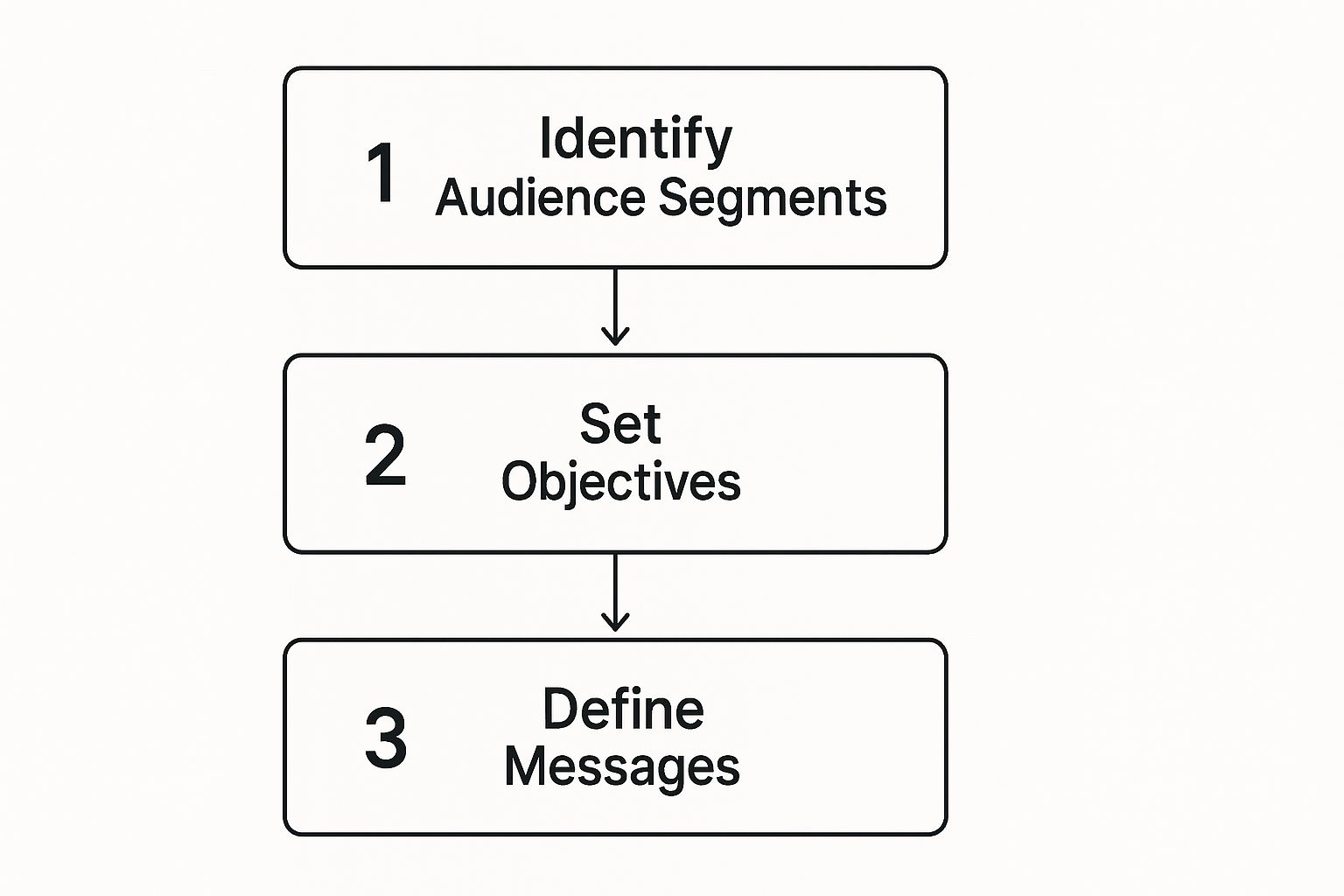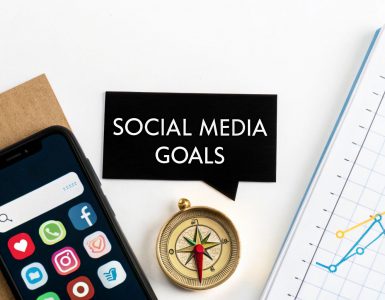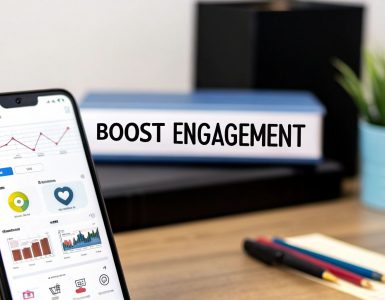A communications strategy plan is your company’s playbook. It’s the master guide that shapes how people see your brand, drives real growth, and builds lasting value. Think of it as the blueprint ensuring every single message—from a quick internal update to a major public announcement—is consistent, has a clear purpose, and directly supports your core business goals. This approach stops communication from being a reactive, fire-fighting task and turns it into a powerful, proactive tool for business.
Why You Absolutely Need a Communications Strategy Plan

Let's be real. In a marketplace this noisy, "winging it" with your communications is a fast track to being completely ignored. Without a solid, written plan, your efforts will feel scattered, your message will get lost, and you'll miss out on key opportunities. A modern communications plan is what brings order to that potential chaos. It's so much more than a document for the PR team; it’s a crucial tool that gets every department on the same page, from marketing and sales to HR and product development.
This kind of alignment means everyone is telling the same story, reinforcing your brand’s promise at every single touchpoint. It fundamentally changes how communication is viewed, shifting it from a "cost center" to a core function that delivers results you can actually measure.
It’s About Strategy, Not Just Tactics
One of the biggest mistakes I see is people confusing a content calendar with a true strategy. A calendar is tactical—it tells you what to post and when. A strategy is foundational—it explains why you're posting it in the first place and connects those daily actions back to your bigger business ambitions.
A strong plan, for instance, helps you:
- Handle Multiple Channels: It gives you a framework to manage communications across all your platforms—owned, earned, and paid—so your brand feels cohesive everywhere.
- Prepare for Crises: A good plan has crisis management built right in. When something goes wrong, you can respond quickly and with a clear head, protecting your brand's reputation before real damage is done.
- Fuel Business Growth: By tying communications to specific outcomes, your plan can be intentionally designed to generate leads, help the sales team close deals, or attract the best talent.
The C-suite is finally catching on. A 2025 report from Cision and PRWeek found that 84% of communication leaders are seeing more engagement from top executives, which proves that comms now has a seat at the strategy table. But here's the catch: the same report revealed that 44% of professionals still struggle to connect their metrics back to business KPIs. This just hammers home how critical it is to have a plan focused on tangible impact.
A great plan doesn't just list what you're going to say. It defines the exact perception you want to build in your audience's mind. It’s the difference between shouting into an empty room and starting a conversation that matters.
Proving Your Worth to the People in Charge
At the end of the day, a communications strategy plan is your best tool for proving your value. It gives you the structure you need to set clear goals, track what's working, and show a direct return on investment.
When leadership asks what your team has accomplished, you won't have to rely on vanity metrics like likes and shares. Instead, you'll have solid data on message resonance, share of voice, and how your work contributed to the sales pipeline.
By building a comprehensive plan, you're setting your organization up to do more than just survive—you're preparing it to thrive. You'll be the one shaping the narrative, not just reacting to it. If you're ready to start building yours, our guide on creating a communications strategy plan template is the perfect place to begin structuring your approach.
Defining Your Goals and Understanding Your Audience
Any great communications strategy starts with two simple but powerful questions: "What are we really trying to achieve?" and "Who are we actually talking to?"
Getting clear on these isn't just a warm-up exercise. It's the foundation for everything that follows. Without this clarity, you're essentially shouting into the void, wasting time and money on messages that don't connect with anyone. This first step is what separates a plan that drives results from one that just creates noise.
Setting Goals That Actually Matter
Before you can figure out what to say, you have to know why you're saying it. This means pushing past fuzzy goals like "increase brand awareness" and getting down to specific, measurable objectives that your team can actually rally behind.
Your communication goals should be directly tied to real business outcomes. For instance, instead of a vague desire for more "awareness," a much stronger goal is to "drive a 15% increase in demo requests from our target enterprise sector within the next quarter." See the difference? One is a wish; the other is a target that directly impacts revenue.
This process is all about creating focus. The more precise your goals are, the easier it is to build the rest of your communications plan. Every choice you make—from the social media channels you use to the content you create—should be a direct line back to these core objectives.
The visual below shows how deeply intertwined your audience, objectives, and messages are. You can't have one without the others.

As you can see, a solid understanding of your audience segments has to come first. It’s what informs the goals you set and the specific messages you’ll need to craft to make an impact.
To make your goals truly powerful, they need to be SMART. This isn't just corporate jargon; it's a proven framework for turning a vague ambition into an actionable plan.
Applying the SMART Framework to Your Communications Goals
Use this table to translate vague objectives into specific, measurable communication goals that align with your business strategy.
| Criteria | Description | Example Communication Goal |
|---|---|---|
| Specific | Clearly define what you want to accomplish. No ambiguity. | Increase organic traffic to our new "Features" page. |
| Measurable | Define how you will track progress and success with concrete numbers. | Achieve 10,000 unique page views on the "Features" page. |
| Achievable | Be realistic. Is the goal attainable with your current resources? | Based on past campaign performance, a 20% traffic lift is realistic. |
| Relevant | The goal must align with broader company objectives, like sales growth. | This traffic will support the sales team's goal of booking more product demos. |
| Time-bound | Set a clear deadline to create urgency and focus. | Accomplish this within the next 60 days (by the end of Q2). |
Using the SMART framework is a non-negotiable step for any team that wants to prove the value of their communication efforts with real, tangible results.
Getting to Know Your Audience Deeply
With your goals set, it's time to shift your focus to your audience. And I mean really focus. This goes way beyond basic demographics like age or job title. An effective plan is built on a deep, almost empathetic understanding of the people you want to reach. What keeps them up at night? What are their career aspirations? Where do they hang out online?
Think of it this way: you wouldn't give the exact same presentation to a room full of software engineers and a room full of hospital administrators. You’d change your language, your examples, and your core points. The same idea applies here.
The best way to do this is by building detailed audience personas. These are semi-fictional profiles, based on real data and interviews, that represent your ideal customers. A good persona digs into their pain points, professional goals, and—critically—where they get their information.
For example, a persona for "Marketing Maria" might reveal she's overwhelmed by data, desperately needs tools that save her time, and listens to marketing podcasts on her commute. That's pure gold. It tells you a message focused on efficiency, delivered via a podcast sponsorship, will hit home far better than a generic LinkedIn post ever could.
This deep dive ensures your message doesn't just get heard—it feels relevant, valuable, and genuinely helpful. It's how you cut through the noise and start building real connections.
The need for such a structured approach is undeniable. Recent workplace communication data shows that a staggering 86% of employees and executives point to poor communication as a reason for failures at work. A thoughtful communications plan built on clear goals and audience understanding is the direct solution. You can explore more of these 2025 workplace communication findings to see just how much a planned approach can improve outcomes. When you properly segment your audience and set SMART objectives, your message becomes dramatically more effective.
Crafting Your Core Message and Choosing Your Channels

Alright, you’ve locked in your goals and you know who you’re talking to. Now comes the fun part: figuring out what to say and where to say it. This isn't about chasing some flashy, viral tagline. It's about developing a central story for your brand—one that’s authentic, consistent, and strong enough to resonate no matter where you share it.
A powerful core message isn't just a slogan; it's the narrative that holds everything together. It explains your "why" in a way that connects with people on a human level, making your brand stick in their minds long after they’ve scrolled past a post.
Developing Your Core Narrative
Your core narrative is the bedrock of all your communications. It needs to be simple enough for everyone on your team to grasp and flexible enough to adapt for different audiences and platforms.
To uncover it, you have to ask some tough questions.
- What problem are we really solving? Think from your customer's point of view, using the pain points you already identified.
- What makes us truly different? Is it your origin story? Your company values? Maybe it's a specific feature nobody else offers. Dig deep.
- What's the "aha!" moment for our customers? Pinpoint that instant when a user finally gets the value you provide. Your messaging should be engineered to trigger that feeling.
Answering these questions helps you get beyond just listing features. You start building a story people can connect with. For example, a software company might go from saying "We offer advanced analytics" to "We give small business owners the clarity to compete with the big players." One is a feature; the other is a compelling narrative.
Modern audiences, especially younger ones, can spot a fake a mile away. Authenticity isn't just a buzzword; it's a requirement. By 2025, Gen Z will make up 27% of the global workforce, and they overwhelmingly favor genuine brand connections over slick marketing. This shift makes human-centric storytelling essential for any communications plan that hopes to succeed.
Choosing Your Communication Channels Strategically
Once you know your story, you need to decide where to tell it. The single biggest mistake I see brands make is trying to be everywhere at once. It’s a recipe for burnout and mediocre results. The smart move is to be selective, pouring your energy into the platforms where your audience is already active and engaged.
A great way to think about your channels is using the PESO model, which breaks them down into four buckets: Paid, Earned, Shared, and Owned. A solid strategy uses a thoughtful mix of all four.
- Owned Media: This is your home turf—channels you control completely. Think your company blog, website, email newsletters, and case studies.
- Shared Media: This is social media. You don't own the platform (looking at you, algorithm changes), but you share content to build a community on places like LinkedIn, X (formerly Twitter), Instagram, or TikTok.
- Earned Media: This is the holy grail: organic word-of-mouth. It includes press mentions, glowing customer reviews, and unsolicited social media shoutouts.
- Paid Media: This is where you pay to play. It includes everything from social media ads and search engine marketing (SEM) to sponsored content.
A Framework For Channel Selection
So, how do you pick the right mix? Evaluate every potential channel against your goals, audience, and, most importantly, your resources. Don't jump on a platform just because it's trending; choose it because it actually makes sense for your brand.
- Audience Presence: Where do your people actually hang out online? If you're targeting C-suite executives, LinkedIn is non-negotiable. If you want to reach Gen Z, you'd better have a plan for TikTok and Instagram.
- Resource Availability: Be brutally honest about what your team can handle. High-quality video production is a heavy lift. A successful blog requires consistent, expert-level writing and SEO know-how. What does your budget and bandwidth really allow for?
- Message-to-Channel Fit: Does your core message even work on the platform? A deep, technical, data-heavy story is perfect for a long-form blog post (Owned Media) but will absolutely die on an Instagram Story (Shared Media).
When it comes to your digital channels, your website is the mothership. It’s often the central hub for everything else you do. Make sure you’re applying key web design best practices so this critical piece of "owned" media is set up for success from day one.
Turning Your Communications Strategy into Action
https://www.youtube.com/embed/r1xv4Nvh-6w
Alright, this is where the rubber meets the road. A great strategy is just a nice document until you put it into motion. You've done the hard work of defining your goals, understanding your audience, and nailing down your message. Now it's time to build the operational engine that brings it all to life.
We're shifting from the "why" to the "how"—transforming those big ideas into a concrete, day-to-day plan.
Start with Your Content Pillars
The first thing I always tell teams to do is establish their content pillars. Think of these as the 2-4 foundational themes your brand will own. These aren't random topics; they should flow directly from your core message and what you know your audience genuinely cares about. They're the guardrails that keep all your content focused and on-brand.
Let’s say you're a fintech company that helps freelance creatives. Your pillars might look something like this:
- Financial Fluency for Creatives: Practical advice on taxes, invoicing, and saving.
- Growing Your Creative Business: Actionable tips for finding clients and scaling up.
- The Sustainable Freelancer: Content focused on avoiding burnout and building a healthy work-life balance.
With these pillars in place, you stop chasing shiny objects. Every blog post, video, or social update has a clear purpose and reinforces the bigger story you're telling.
Build Your Content and Editorial Calendar
Once your pillars are set, the next step is building your content calendar. A good calendar is so much more than a schedule—it’s the command center for your entire communications plan. It’s where you map out specific topics, decide on formats, assign channels, and set deadlines. It turns your strategy into a tangible workflow.
Planning ahead is non-negotiable. According to one study, the average employee dealt with 10 planned organizational changes in 2022. That's a massive leap from just two back in 2016. In that kind of environment, you can't afford to be reactive. A calendar forces you to be proactive, anticipate what's coming, and coordinate your efforts.
I recommend starting with the big rocks: map out your major events, product launches, or seasonal campaigns for the quarter. Then, you can fill the gaps with content that supports your pillars. This is also where you get to experiment with different formats to keep things fresh. If you want to dive deeper, we have a complete guide on how to create a marketing calendar for your blog that aligns perfectly with these strategic goals.
Get More Mileage with Content Repurposing
Creating truly great content takes a ton of time and resources. The smartest communicators I know don't just create—they multiply. Content repurposing is the art of taking one core piece of content and spinning it into multiple formats for different channels. It’s the single best way to maximize your reach and squeeze every drop of value out of your work.
A single, in-depth research report can be the source of a dozen smaller content pieces. This isn't about being lazy; it's about being efficient and respecting the different ways people consume information across various platforms.
Imagine this workflow:
- The Pillar Asset: You start with something meaty, like a comprehensive webinar.
- Blog Posts: You can easily pull key sections from the webinar and expand them into detailed blog articles.
- Social Media Graphics: Grab the most powerful quotes and stats to create shareable images for LinkedIn or Instagram.
- Short-Form Video: Edit the most compelling 60-second clips for TikTok and YouTube Shorts.
- Email Newsletter: Summarize the webinar's main takeaways into a concise, valuable email for your subscribers.
This approach ensures your message hits your audience from multiple angles, reaching them on the platforms where they're already spending their time. You stop being a content factory and start becoming a strategic content powerhouse. To see this in action on a grand scale, check out the strategies behind iconic rebranding examples; they almost always involve a massive, brilliantly coordinated content plan.
Measuring Performance and Optimizing Your Strategy

Here's where the rubber meets the road. Your communications strategy isn't a "set it and forget it" document; it's a living guide that needs to breathe and adapt to stay effective. This is often the trickiest part because you're moving from planning to proving.
Success here means looking past vanity metrics like likes and shares. You have to focus on what actually moves the needle for your business. The real goal is to measure impact in a way that resonates with leadership—think message penetration with your key audiences, your share of voice in the industry, and genuine lead generation from your communication efforts. It's about confidently answering the question, "What did we get for our investment?"
Adopting a Measurement Framework
To measure anything well, you need a framework. A good framework saves you from drowning in a sea of data and keeps your reporting laser-focused on the goals you set at the beginning. One of the most respected frameworks out there is the set of Barcelona Principles, which champions the idea of measuring outcomes over outputs.
What does that mean in practice? Instead of just counting how many press releases you sent (an output), you measure how that activity actually influenced audience perception or drove traffic to your website (outcomes). This shift is absolutely fundamental to proving the value of your entire communications strategy plan.
This is all about tying your activities directly back to those SMART goals. If your goal was to increase demo requests, your primary metric isn't your social media engagement rate; it's the number of demos you can trace directly back to your communications work.
Key Metrics That Actually Matter
While your specific KPIs will depend on your unique goals, some metrics provide much deeper insights than others. It's time to move beyond surface-level numbers and dig into the data that tells a real story.
- Message Resonance: Are your key messages actually being picked up and repeated by your target audience or the media? You can track this with media monitoring and social listening tools.
- Share of Voice (SOV): How much of the conversation in your industry is about your brand versus your competitors? This is a powerful benchmark for tracking brand awareness.
- Audience Engagement Quality: Look past the sheer number of comments and analyze the sentiment. Are people asking thoughtful questions and having genuinely positive conversations?
- Conversion Metrics: This is the bottom line. Track how many people took the action you wanted them to, like downloading a whitepaper, signing up for your newsletter, or requesting a call with sales.
A critical mistake is letting frontline leaders express skepticism about a new strategic direction, as it can be a recipe for failure. To prevent this, data from your communication efforts can be used to demonstrate early wins and build buy-in, showing them that the plan is already taking root and gaining traction with customers.
The Cycle of Review and Optimization
Measurement isn't a one-time report you file away and forget. It's an ongoing cycle of analysis and adjustment. A solid communications strategy plan includes a regular cadence for review—I recommend monthly for tactical check-ins and quarterly for bigger, more strategic assessments.
During these reviews, you have to be ready to ask the tough questions:
- What's Working? Pinpoint your top-performing content, channels, and messages. Double down on what's clearly a winner.
- What's Not Working? Be brutally honest about what's falling flat. Is a specific channel a ghost town? Is a content pillar failing to get any traction? Don't be afraid to pivot away from what isn't delivering.
- Why? Dig into the reasons behind your results. Was it bad timing, the wrong format, or was the message itself off?
- What Will We Change? This is the most important step. Turn your insights into action. This is how your plan evolves and gets smarter over time.
This agile approach is essential in today's environment. Research shows the average employee now experiences 10 planned organizational changes per year, a huge jump from just two back in 2016. Your communications have to be just as adaptable. Measuring social media ROI is a huge part of this; you can learn more about how to accurately measure social media ROI in our detailed guide.
By consistently measuring, reporting, and optimizing, you transform your communications from a purely creative function into a data-informed growth driver for the entire business.
Answering Your Toughest Communications Plan Questions
Even with the best guide in hand, putting a communications plan into practice always brings up a few tricky questions. I get it. The real world is messy. Here are some answers to the most common sticking points I've heard from pros just like you.
"How Often Should I Actually Look at This Thing?"
One of the biggest mistakes I see is treating the communications plan like a sculpture—carved in stone once a year and then left on a shelf to gather dust. Don't do that. Think of it more like a living, breathing guide that needs a little attention to stay useful.
I’ve found a two-pronged approach works best:
- Quarterly Strategic Huddle: Every three months, zoom out. Get your team together and ask the big questions. Are our main goals still what the business needs? Has our audience changed? Is a competitor suddenly eating our lunch? This is your chance to make bigger course corrections.
- Monthly Tactical Check-in: Once a month, get into the weeds. Look at your metrics. Is that LinkedIn campaign actually working? Is our blog content getting more traction than our videos? These quicker meetings are for making small, smart adjustments to what you’re doing day-to-day.
This rhythm keeps you agile enough to react to what’s happening right now without throwing your entire strategy into chaos every few weeks.
"Wait, Isn't This Just a Marketing Plan?"
A fantastic and super common question. The line between communications and marketing can get incredibly blurry, and honestly, they should be working hand-in-glove. But they have different jobs.
| Aspect | Communications Plan | Marketing Plan |
|---|---|---|
| Primary Goal | Build and guard the company's reputation and manage relationships. | Drive sales and bring in revenue. |
| Key Audience | Much broader: employees, investors, the media, the community, and customers. | More specific: current and potential customers. |
| Core Focus | The story, the brand's perception, and building trust. | Product, price, placement, and promotion (the classic 4 Ps). |
| Typical Tactics | PR, internal communications, crisis management, corporate social responsibility. | Ads, SEO, email campaigns, lead gen. |
Here's the simple way I think about it: Marketing sells, and communications builds the relationships and reputation that make selling possible. A brilliant marketing plan will fall flat if people don't trust or understand the company behind it.
"How Do I Get My Boss to Actually Care About This?"
Getting leadership to sign off on a comms plan, especially if they see it as "fluffy stuff," is a classic challenge. The secret is to stop talking about comms and start talking their language: results and revenue.
Your plan isn't just a collection of cool ideas. It's a business proposal.
Tie every single one of your communication goals directly back to a company-wide business objective. If the company wants to crack a new market, you need to show exactly how your plan will build the brand awareness and credibility to make that happen.
Use the SMART goals we talked about earlier. Don't say, "We'll do better on social media." Instead, present it like this: "Our Q3 LinkedIn campaign will generate 50 qualified leads for the sales team, directly supporting their 10% revenue growth target."
When you connect your work to real business impact, you're not asking for a budget—you're presenting a strategic investment.
"What If I Have a Tiny Team and No Budget?"
Welcome to the club! This is the reality for so many of us. But here’s the upside: having a solid plan is even more crucial when you're short on resources. It forces you to be absolutely ruthless about where you spend your time and money.
A tight budget means you can’t afford to waste a single second on something that isn't working. Your plan is the tool that helps you make those hard calls.
A few survival tips I've learned along the way:
- Get Laser-Focused. You can't be everywhere. Your audience research should point you to the one or two channels where you can make the biggest splash. Go all-in on those and forget the rest for now.
- Repurpose Everything. This is your new religion. Squeeze every drop of value out of your content. That webinar you hosted? It can become five blog posts, ten social media graphics, a handful of short video clips, and an email newsletter.
- Lean into Your Owned Media. Your blog and your email list are gold. You control them completely. Pour your energy into building these assets because they almost always deliver the best long-term return on your effort.
A great plan gives you the confidence to say "no" to the million distractions and a firm "yes" to the handful of things that will actually move the needle.
Stop wasting hours on manual social media updates. EvergreenFeed automates your evergreen content scheduling so you can focus on strategy, not spreadsheets. Integrate with Buffer, set your schedule once, and watch your social channels stay active with high-value content. Sign up for free and start automating today.




